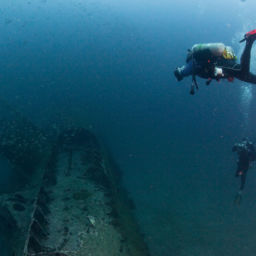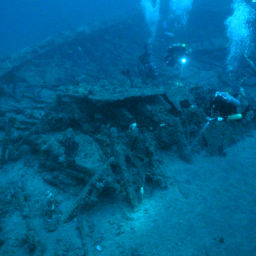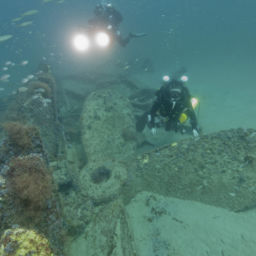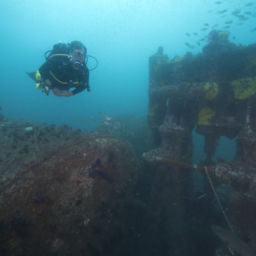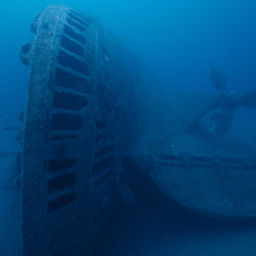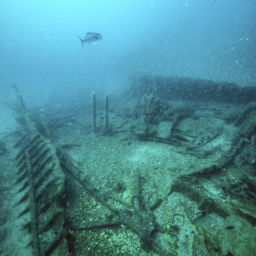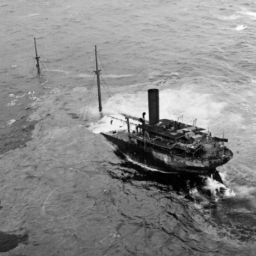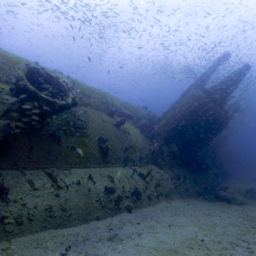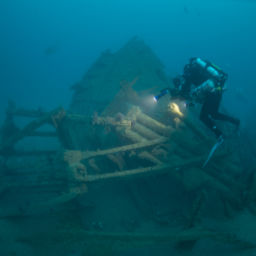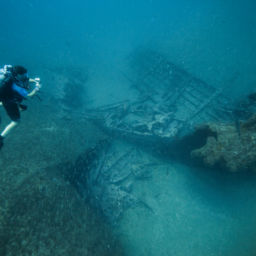From January to the end of August 1942, German U-boats attacked more than 285 vessels in North American waters. Just off coastal North Carolina, the remnants of many of these ships lie on the ocean floor. The remains of this little-known battlefield serve as the final resting place for 90 ships and nearly 1,700 men lost during the Battle of the Atlantic. Over the course of the battle, eight Allied convoy vessels, 78 merchant freighters and tankers and four German U-boats sank off North Carolina’s coast. Each shipwreck tells a unique story; today we visit U-701.
U-701 sinks
On May 20, 1942, the crew of U-701 left Lorient, France for a third and final patrol in conjunction with six other U-boats. Five of the seven, including U-701, left for special missions and represented possibly the most aggressive coordinated U-boat assault on the U.S. during WWII. U-701 set out to mine the Chesapeake Bay area.
On June 12, good visibility from the lights of Cape Henry and Cape Charles helped U-701 lay mines. It took just 30 minutes for the U-701 crew to strategically and accurately lay 15 delayed-action TMB mines at the entrance to the Chesapeake Bay, directly in the shipping channel. The minefield would prove effective, sinking two ships and severely damaging three more.
U-701 then headed to Cape Hatteras, North Carolina, to look for additional targets. On June 19, U-701 spotted a small U.S. Navy patrol boat, USS YP-389. Worried that the vessel might give away their location, the U-701 crew decided to use the deck guns to sink the vessel. After a brutal exchange of fire between the two vessels that lasted for over an hour, YP-389 sank beneath the water.
U-701’s success continued the following week when it fired two torpedoes, hitting and damaging the tanker William Rockefeller. It returned later that evening to fire the final blow, sinking the tanker.
On July 7, U-701 patrolled off Cape Hatteras and surfaced to freshen the air in the U-boat. As the submarine sat on the surface of the water, the first watch officer failed to spot an Army Air Force Hudson, piloted by Lieutenant Harry Kane out of Cherry Point, North Carolina. Kane dropped three 325-pound depth charges just as U-701 attempted to crash dive. Although the U-boat was already underwater when the charges hit, the damage prevented U-701 from blowing the ballast tanks and surfacing. Therefore, the survivors most likely escaped from U-701 as it sat on the bottom. All but seven of the crew escaped. Kane radioed a position and dropped a smoke flair but could not offer any other assistance to the survivors. Kane and his crew were hailed as heroes with the first defeat of a submarine from the air by American forces.
The surviving U-701 crew of 36 drifted with the Gulf Stream for 49 hours. On July 10, the Navy blimp K-8 spotted the survivors and called in a Coast Guard sea plane. The plane landed and found only seven surviving crew members, including the captain. Suffering heavily from exposure, the seven survivors became prisoners of war and remained in various camps in the U.S. until the end of the war.
Diving U-701
The wreck of U-701 remained completely undisturbed for 47 years until a recreational diver discovered it in 1989. The diver kept the ship’s location secret from the larger diving community, but following a hurricane in 2004, other divers rediscovered the site and today it is quite popular.
The wreck sits in about 110 feet (34 m) of water in shifting sands and currents where the Gulf Stream and Labrador Current collide off Cape Hatteras, North Carolina. U-701 is partially buried on the sandy bottom and the strength of the ocean currents on the site vary widely from slight to very swift. Stronger currents typically result in scour around the wreck that leaves more of the U-boat’s port side exposed than the starboard side.
“U-701 is one of the best examples of a German Type VIIC U-boat off the U.S. East Coast, as the submarine remains mostly intact,” says Tane Casserley, Monitor National Marine Sanctuary’s research coordinator and a maritime archaeologist.
“The sand can vary as much as 10 feet year-to-year, giving divers a different view each year they dive on it. The outer hull fairing also has a remarkable degree of preservation, providing divers a true sense of how devastating this weapon was to our unarmed merchant ships during World War II’s Battle of the Atlantic.”
Depending on the current, visibility also varies, but commonly ranges from 10 to 40 feet (3 to 12 m). The site is typically accessible to recreational divers year-round, with summer water temperatures ranging between 70 and 80 F (21 to 27 C) and winter temperatures typically in the low- to mid-60s (16 to 17 C). The shipwreck’s vertical relief is in stark contrast to the surrounding sandy seafloor. Its structure serves as hard substrate for encrusting marine organisms and provides shelter for many species of marine life. When conditions remove large amounts of sediment, U-701’s forward diving planes, propellers, and rudders are also exposed.
An Expanded sanctuary
In an effort to honor the service and sacrifice of those lost during the Battle of the Atlantic, NOAA in 2019 will release a draft proposal to expand the boundaries of Monitor National Marine Sanctuary to include a nationally significant collection of shipwrecks that currently have little or no legal protection. The expansion would also establish the largest area designated as a World War II battlefield anywhere in the world. U–701
To learn more about the proposal, click here.











